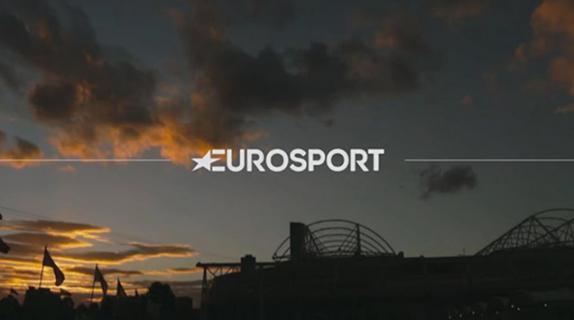It’s been a big year for Eurosport. In July, Discovery acquired full ownership of the sports channels TV network, which airs in more than 99 countries, to about 243 million subscribers across the globe. The acquisition followed yet another landmark deal in June, which saw Eurosport/Discovery winning the TV and multiplatform rights for the Olympic Games from 2018 to 2024.
Then, in November, Eurosport commemorated this new era in its 26-year history with a rebrand of seismic proportions.
London-based brand agency DixonBaxi led the rebrand, working closely with the Eurosport team on every aspect as it developed the creative strategy, on-air brand, multiplatform graphic system, off-air advertising and a 30-second launch spot. The resulting identity bursts off the screen with a sweeping portrayal of sports that somehow feels both epic and intimate, placing the fans first and building everything around their energy and passion.
One of the primary building blocks in this modern paean to fandom is a powerful sound design by frequent DixonBaxi collaborators Massive Music, whose array of primal drumbeats, melodic chants and real-world sound effects coheres with the imagery to place the viewer directly inside the on-screen moments.
Massive Music’s entry point to this propulsive sonic branding was unusual, explained Paul Reynolds, the company’s managing director, in that it produced a song representing Eurosport’s core tenets before doing anything else. The full two-minute track that ensued is a marvel of rising energy, replete with foot stomps, hand claps, squalling guitar and a spine-tingling vocal element that somehow resembles the musical version of a soccer chant. Once composed, the song was dissected and parsed throughout the brand in ways that elevate the visual on-air elements from beautifully composed images to moment-to-moment encapsulations of visceral experience.
“Our goal was always to realize sport as it’s seen and experienced by the fans and players, [which is] never staged or set up – real sport that is vibrant, authentic and relatable, with a gritty underbelly,” said Dan Capstick, creative director at DixonBaxi, via email. “With our audio we wanted to continue this ethos by creating a sonic space that was uplifting, instantaneous and live. We felt it was time for Eurosport to forget ‘broadcast music’ and create something truly fresh and innovative.”
Massive eschewed computer-made audio in both its music and sound design for Eurosport. The song’s instruments were recorded live, the pulse-pounding drumbeats played on a drum kit, the stomps and claps recorded by Massive staff in their studio. Sound effects were created with real-world materials in strange and innovative ways. A bucket of water was poured over a sound designer’s head to capture a breathing noise for a swimming ident. An actual slab of ice was cracked on a microphone for a skating ident. The list goes on.
The cumulative effect of these layers of human touches is a feeling of raw immediacy across the new identity, culminating in explosive IDs and bumpers referred to by the creatives as “Peak Moments.”
Peak moments, explained Capstick, “do not celebrate a stereotypical sporting image of victory, glory or elation. Peak moments are the most intense and crucial event in a game, match, race or event. It’s the break back on the third set that turns the game around; the spot-on super-quick pit stop that puts our driver into the lead; the intensity of focus in the split second before the starter pistol fires, that puts the sprinter over the line by a nose. It’s all about the moment within the game.”
For Massive Music, truly immersing the viewer into those Peak Moments was not merely a matter of finding the right sound effect to match with the on-screen visual.
Instead, said Reynolds, “we were approaching each visual element by making a sound world around it, so not necessarily just what you see on the screen. You may be looking at oil, which is just bubbling away, but there’s a whole world of things going on at that time. There’s screaming, the tires are vibrating on the ground. We literally put the viewer as if they were in the gear box.”
Using sound to literally put audiences inside a given sports moment involved envisioning that moment as a macro environment and speculating what it would be like to be the size of a bug that’s sitting at the center of it.
“Imagining everything around us as giant,” said Reynolds, enabled Massive to produce audio that, when applied “to a ... a normal perspective, [got] an amazing result.”
When a tennis racket strikes a ball, for instance, we don’t just get the thwack of the strings – we get the humming vibration of the strings post-strike, as though we were little ladybugs clinging to them. Or when we see an athlete blinking the sweat from his eyes, we hear the soft, crinkly crunch of skin and lashes and eye crust coming together, as though we were little mites chilling near his temple.
This unorthodox interplay between sound and visuals, said Capstick, lets the Eurosport mnemonic take on the “sonic behaviours of each scenario, so that it becomes part of the fabric of the brand and not a tag-on jingle.”
Paying close attention to the final moment of each bumper below reveals this phenomenon in action. While the movement of the Eurosport logo is always paired with the same percussive slice from the brand song, it has a different feeling each time out from how it gets woven into the unique audio blanket enveloping it.
“You’ve got to be careful… because with some [sonic] identities you can really annoy people,” said Reynolds. “You have to be very, very careful if you do something very musical. The great thing about this one is because it’s a percussive element, it can sit across anything. It can sit over other music, sit with voice, sit over sound design, or it can sit by itself. It becomes really versatile.”
For more information about the Eurosport rebrand, check out the DixonBaxi case study.
Tags:












































__twocolumncontent.jpg)











